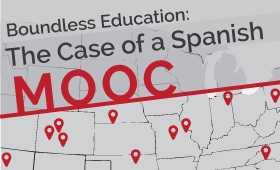Boundless Education: The Case of a Spanish MOOC
 By Fernando Rubio, Co-Director, Second Language Teaching and Research Center, Associate Professor of Spanish Linguistics, University of Utah.
By Fernando Rubio, Co-Director, Second Language Teaching and Research Center, Associate Professor of Spanish Linguistics, University of Utah.
After teaching for more than 20 years, I have decided that I really do not care much about teaching. The only thing that I care about is learning. And that is the reason why in the spring of 2013, I embarked in my first Massive Open Online Course (MOOC) experience teaching what, to my knowledge, was the first language MOOC ever offered. I saw the opportunity to teach this course as an ideal way to get valuable insight into students’ learning. The prospect of having access to learner analytics for a very large and diverse group of students exposed to the same learning conditions was too good to pass up. The course, Improving your Spanish Pronunciation, was one of 8 courses that were part of the first batch of MOOCs offered by Canvas Network, a massive open online course platform developed by Instructure (http://www.instructure.com). Canvas decided to cap enrollments in those first few courses at 500 students in order to keep things manageable. This course was a basic and practical introduction to Spanish phonetics and phonology, open to anyone with a basic knowledge of the language. It was a simplified version of a course that I had taught many times before, both in face-to-face and hybrid formats. Offering it now as a MOOC also provided a good opportunity to compare student learning in the different contexts. In this article, I want to share some of the lessons I have learned through this experience, particularly those most relevant to student learning.
HUNDREDS OF STUDENTS + NO FACE-TO-FACE CONTACT = LOTS OF WORK
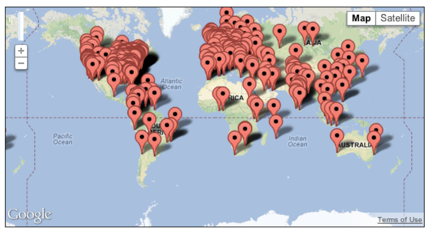
In his article “Three Must-Knows on Distance Ed” (Inside Higher Ed, September 10, 2013), Joel Shapiro claims that a “key in determining the effectiveness of a course, both online and on the ground, is how actively it is being taught and how effectively it is engaging students.” That is definitely true in a language course, but a challenge with 500 students. I was able to overcome this challenge using the following three strategies:
-
Active instructor presence: I had the fortune to have two assistants working with me on this MOOC. We divided the day among the three of us so that one would always be virtually present to respond to students’ inquiries or requests for help as quickly as possible, typically within a few hours. We also shared the responsibility for providing feedback on students’ assignments when needed.
-
Detailed rubrics: Individualized and detailed feedback is crucial in a class that targets pronunciation. Students expect it. In order to
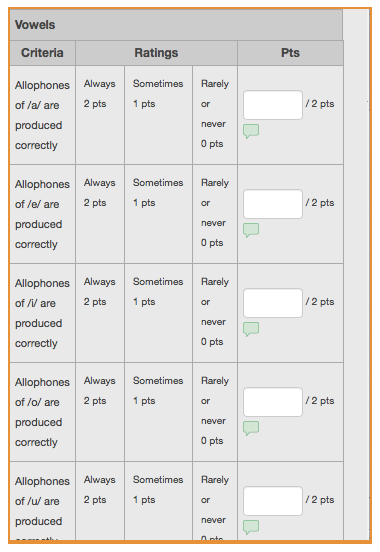
On-screen rubric in Canvas. facilitate our task when dealing with open-ended activities, I spent a significant part of the course design phase developing specific and detailed rubrics for each assignment. These rubrics are available on the screen as the instructor grades each assignment. In addition to assigning points, individualized comments can be added to each grading criterion. This expedited the grading process and it made the instructor presence more obvious.
-
Self- and peer-evaluation: Although self and peer-evaluation are not routinely used in phonetics and pronunciation courses, my experience with this course showed that, with enough guidance and, again, very clear rubrics, students are able to evaluate their own and their peer’s pronunciation with a high degree of accuracy and therefore they can receive and provide valuable feedback. Self-evaluation was also facilitated by the use of Audacity as the audio editor and recorder for the course. Audacity is an open source software that includes a variety of very useful features for a language course, such as record and play high quality audio, including creating multi-track recording, import and export in a variety of formats, easy editing, a spectrogram view mode, etc.
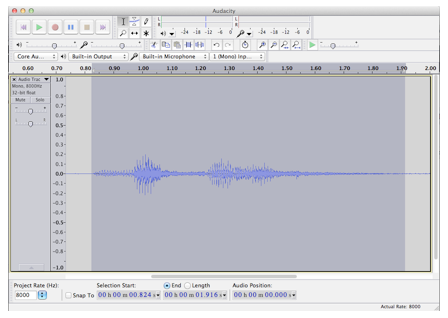
IF YOU BUILT IT, WILL THEY COME?
From their inception, MOOCs were touted by many as a disruptive force in education. 2013, dubbed “The year of the MOOC” by the New York Times, opened with a New York Times op-ed published on January 26, in which Thomas Friedman shared his very optimistic assessment of the model. According to Friedman, “nothing has more potential to unlock a billion more brains to solve the world’s biggest problems. And nothing has more potential to enable us to reimagine higher education than the massive open online course.” However, before the year was over, another New York Times article tempered the initial excitement by mentioning, among other shortcomings, the very low completion rates (about 4 percent) reported by a million users of MOOCs conducted by the University of Pennsylvania’s Graduate School of Education. I have to admit that my own massive online course suffered a similar fate and only about 9% of those enrolled completed more than 80% of the course content including the final assignment. Although disturbing at first, I have since learned to see the silver lining.
In a comment posted to the e-Literate blog in March 2013, Phil Hill, an education technology consultant, describes the patterns of participation in MOOCs. The table below shows the categories that Hill identifies. Of the five categories, only active participants exhibit the typical patterns of engagement of students enrolled in regular courses. In Hill’s definition, active participants are those who “fully intend to complete your course, consume most of the content, complete most of the quizzes, and even submit assignments where applicable.”
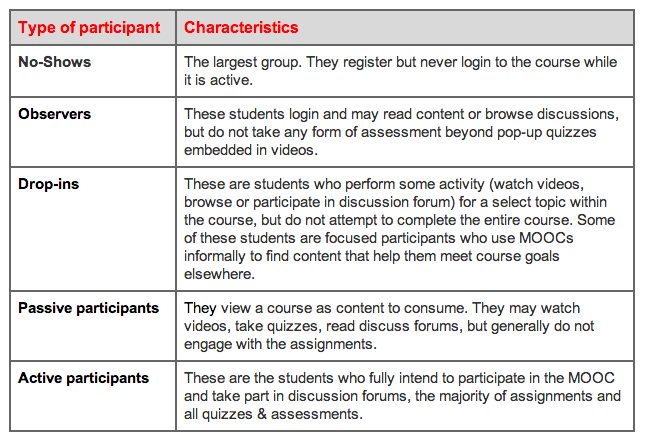
The reality of MOOCs is that only a small percentage of those registered are in fact active, which explains the dismal completion rates that many MOOC opponents claim as evidence of failure of the MOOC model. The problem I see with that claim is that MOOCs, particularly those offered through institutions of higher education, exist at the currently unstable intersection between teaching and credentialing. Many of us have spent our careers in academic institutions, where the goal is to prepare learners and then certify/credential them. But the reality of MOOCs is that a majority of participants already hold degrees, many have graduate degrees or are professionals who see the MOOC as an opportunity to add a valuable skill, not to earn a certificate, or simply to learn something that they have always been interested in. The chart below shows how students in my course responded to the basic biographical information questions when they registered. As the chart shows, only a small percentage of the participants were students in the institutional sense of the word while the majority indicated that they were taking the course to satisfy their personal interest.
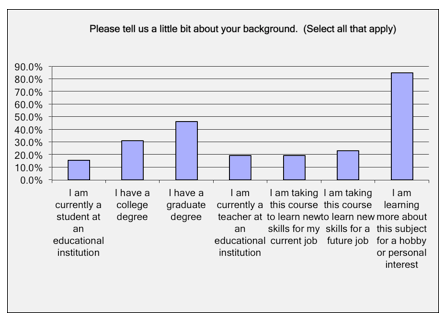
On October 1st, 2013 The Economist published a commentary on MOOCs titled Will MOOCs Kill University Degrees? The author uses a metaphor that describes beautifully why MOOCS’ dismal completion rates should not be used as a measure of failure:
“Most people (including your correspondent) enroll for these free courses for enjoyment, enlightenment or curiosity and are not committed to finishing them or gaining a certificate. (Mozart may have written “The Magic Flute” with the intention that you listen to the entire opera, but just playing the overture does not mean that either he or you have failed.) Indeed, the optimal consumption of a MOOC for any given student may actually only be part of the course.”
So even if only 44 of the 500 students who initially registered for my course actually completed it (in the most restrictive sense of the word), it is quite possible that many more learned something from it.
IMPLICATIONS FOR INSTRUCTORS
Here is a summary of some reflections that also serve as suggestions for anyone considering embarking in a similar adventure. Obviously, most of these suggestions apply to any online asynchronous course or, as a matter of fact, when designing and teaching any course in any format.
Over prepare
I was given this piece of advice when I was a teaching assistant in graduate school: “always over prepare so you don’t underperform”. This is even more applicable when you are teaching online and particularly a MOOC. The more time you spend on the design phase of the course, the higher the chances of a smooth delivery. In essence, by the time the course starts, the entire course must be ready: readings, assessments, rubrics, discussions. Everything. And every component needs to be working perfectly; there is simply no time once the course starts to make any significant changes or deal with design issues.
I had originally conceived this course as a series of modules that would need to be completed sequentially. That is, a student would have to go through all the components of module 1 in a sequence before he/she would have access to module 2, etc. However, Canvas Network insisted that I made the modules available to students without any prerequisites. I found this perplexing at first since this meant that someone could ignore, say, the first 3 modules of the course and go directly to module 4 not having the necessary background knowledge to deal with the content. I later came to appreciate the reasons behind Canvas Network’s approach: this was not a regular course; it was a MOOC. That means that students take what they want and ignore what they are not interested in. Forcing them to go through a pre-determined sequence would make the course much less appealing for that type of student. This also implies that you cannot design a course in which a unit is too dependent on knowledge acquired in the previous one and you cannot make too many assumptions about what students know as they engage with the material. In practice, it means that you have to design the course very carefully and make sure that you provide enough support and scaffolding within each unit.
It takes a village
A massive online course, particularly in its first iteration, can only be successful if its design is the product of a team effort. Although most instructors who take on this type of challenge are probably technophiles themselves, getting support from IT professionals is crucial. My MOOC included short self-generated video lectures, audio recordings, audio feedback, assignments in which students had to record themselves, links to external sources, etc. Prior to the beginning of the course, instructors need to ensure that all those elements will work when students access them from their laptops, desktops, mobile devices, through a variety of browsers, etc. You also want to guarantee that access to the materials will not require an unrealistically fast Internet access. Ideally, an IT professional should go through all the course components to check for potential problems before they happen.
Designing a MOOC is a challenging task that will benefit from multiple perspectives. In my case, the course went through two invaluable design reviews by the Canvas Network staff, as well as countless consultations with a team of instructional technologists at my institution. The key, as I learned early on, is to think about affordances and how your course design will condition or facilitate the students’ interaction with the material, yourself and with one another.
Finally, an instructional team is essential for effective delivery of a massive course. As I mentioned above, the sheer number of students would make it almost impossible for one person to deal with the demands of such as course.
Learning is learning regardless of the medium
Most language teaching professionals would agree that one learns a language through exposure to large amounts of input and to adequate feedback, the opportunity to produce output and the availability of rich opportunities for interaction. Regardless of the format that a course follows, those ingredients are crucial in the process of language acquisition. The physical classroom may facilitate some of those conditions as compared to the online environment, but an online environment may prove advantageous in other situations. Oral interaction, for example, is easy to facilitate in a face-to-face format and much more challenging—although not impossible—online. Oral individualized feedback, particularly in a course like this with a focus on pronunciation, is more feasible online than it would be in a physical classroom. The chart below indicates what percentage of students indicated that a component of the course was important or very important in their learning process. As you would expect, interaction plays a much smaller role in this course than it would in a language course in which the focus is on developing communicative competence, but the importance of the other ingredients is quite predictable. In fact, it is exactly the same reaction that I get from students when I teach the course face-to-face: they love the opportunities to produce and the extensive individualized feedback.
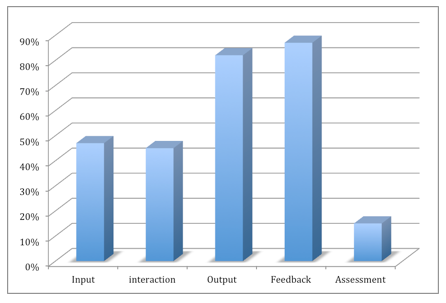
WHAT’S NEXT?
While I taught my MOOC in the spring of 2013, I posted about the experience on the Open Up blog of the Center for Open Educational Resources and Language Learning at the University of Texas, Austin. I likened MOOCs to cell phones. It took two decades for the old clunky, heavy and expensive brick phones to become what they are today. And nobody could have imagined 20 years ago the kinds of things that cell phones allow us to do today. In August, 2013, Gartner, Inc. the world’s leading information technology research and advisory company
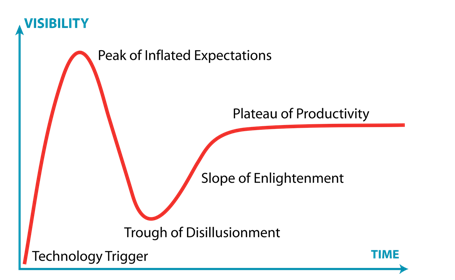
published its 2013 hype cycle for emerging technologies. What you see below is a simplified version of their graph which, I think, is a remarkably appropriate way to describe what has happened with MOOCs so far and what the future may have in store hold. According to Gartner’s cycle, every technological innovation starts with a “peak of inflated expectations” upon its release, followed by a deep “trough of disillusionment” that leads to a “slope of enlightenment” until finally a “plateau of productivity” is reached. I think that the evolution that I pointed up above illustrated by the New York Times articles in 2013 mark the high and the low and that we are at the point now where we are starting to realize the real potential of massive online open courses.
RESOURCES
Two blogs from the Center for Open Education Resources and Language Learning at UT Austin:
Davidson, Cathy. “What Can MOOCs Teach Us About Learning?” HASTAC: Humanities, Arts, Science and Technology Alliance and Collaboratory. January 10, 2012. http://www.hastac.org/blogs/cathy-davidson/2012/10/01/what-can-moocs-teach-us-about-learning
E. Dahlstrom, J.D. Walker & C. Dziuban. “ECAR Study of Undergraduate Students and Information Technology.” EDUCAUSE: Center for Analysis and Research. September 16, 2013. http://www.educause.edu
Fernando Rubio, “Why I Love and Hate My Spanish MOOC,” COERLL: Conversations on Open Education for Language Learning (blog), February 12, 2013, https://blog.coerll.utexas.edu/why-i-love-and-hate-my-spanish-mooc/.
Guerriero, Michael. “A MOOC Mystery: Where do online students go?” THE NEW YORKER. February 28, 2014. http://www.newyorker.com/online/blogs/newsdesk/2014/02/a-mooc-mystery-where-do-online-students-go.html.
“MOOC de Espanol: Curso abierto para hablantes de ingles que deseen mejorar su espanol,” The Mixxer: Language Exchange for Everyone (blog), http://www.language-exchanges.org/node/106804.
“MOOCs Forum,” Mary Ann Liebert, Inc. publishers (blog), September. http://online.liebertpub.com/toc/mooc/1/P.
R.J. Clougherty Jr. & Viktoria Popova. “Crowdsourcing to Assess MOOCs: A Position Paper.” MOOCs FORUM. September 2013, (10-13) .
S. Grajek, J. Bichsel. & E. Dahlstrom. “What Moocs Mean to Today’s Students and Institutions.” EDUCAUSE: Center for Analysis and Research. October 7, 2013. http://www.educause.edu/ir/library/pdf/ECAR_SO/ERB/ERB1309.pdf
Todd Bryant, “MOOCs + Learning Networks = The Mixxer.” COERLL: Conversations on Open Education for Language Learning (blog), January 29, 2013. https://blog.coerll.utexas.edu/moocs-and-learning-networks-equals-mixxer/.
Vanessa P. Dennen & Amit Chauhan. “Shall We MOOC? A SWOT Analysis at the Program Level.” MOOCs FORUM: Mary Ann Liebert, Inc. publishers. September, 2013, (17-21). http://online.liebertpub.com/doi/abs/10.1089/mooc.2013.00.
Veletsianos, G. “Learner Experiences with MOOCs and Open Online Learning.” Hybrid Pedagogy. 2013. http://learnerexperiences.hybridpedagogy.com.

